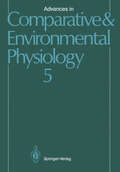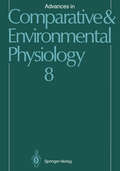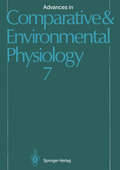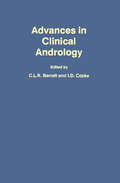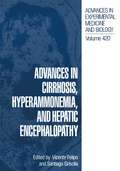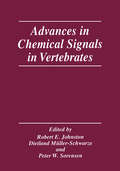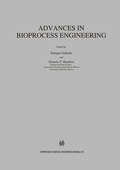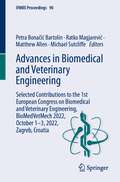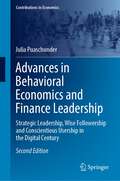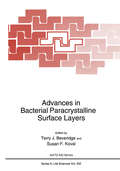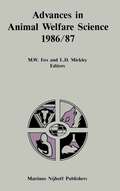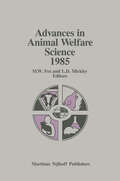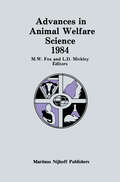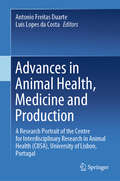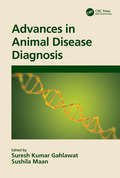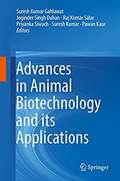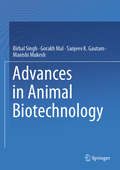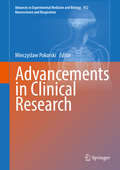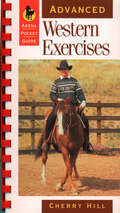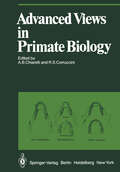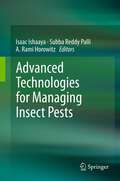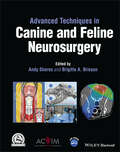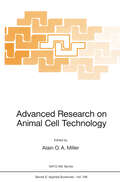- Table View
- List View
Advances in Comparative and Environmental Physiology (Advances in Comparative and Environmental Physiology #5)
by M. Brouwer W.E.S. Carr W. Ross Ellington D. W. Engel R. A. Gleeson B. Korsgaard T. S. Moerland T. Mustafa D. J. Prior B. D. Sidell K. C. Srivastava H.G. Trapido-Rosenthal R. E. Weber R. W. WisemanAdvances in Comparative and Environmental Physiology helps biologists, physiologists, and biochemists keep track of the extensive literature in the field. Providing comprehensive, integrated reviews and sound, critical, and provocative summaries, this series is a must for all active researchers in environmental and comparative physiology.
Advances in Comparative and Environmental Physiology: Volume 8 (Advances in Comparative and Environmental Physiology #8)
by M. A. Castellini B. Fievet S. C. Hand R. Motais B. Pelster R. E. WeberAdvances in Comparative and Environmental Physiology helps biologists, physiologists, and biochemists keep track of the extensive literature in the field. Providing comprehensive, integrated reviews and sound, critical, and provocative summaries, this series is a must for all active researchers in environmental and comparative physiology.
Advances in Comparative and Environmental Physiology: Volume 7 (Advances in Comparative and Environmental Physiology #7)
by D. F. Houlihan D. R. Livingstone R. F. LeeAdvances in Comparative and Environmental Physiology helps biologists, physiologists, and biochemists keep track of the extensive literature in the field. Providing comprehensive, integrated reviews and sound, critical, and provocative summaries, this series is a must for all active researchers in environmental and comparative physiology.
Advances in Clinical Andrology
by I. D. Cooke C. L. R.BarrattInfertility is a problem for the couple and evaluation of the couple is preferable in a clinic where both males and females may be seen together. The contribution to care by the urologist and the gynaecologist each with an interest in infertility is different but complementary. My appreciation of this was sharpened between 1976 and 1985 during my association with the World Health Organization's Spe cial Programme of Research Development and Research Training in Human Reproduction at the meetings of the Steering Committee of its Task Force on Infertility. The deliberations of this group were aimed at developing a protocol for investigation of the infertile couple and it became apparent to me as a gynaecologist how important is the precise characterization of the male partner's role to the formulation of the management plan for the infertile couple. To improve the quality of our evaluation of the male partner our techni cal staff were trained in the semen methodology of the laboratory of Dr F Com haire of Ghent and we were joined by Dr CLR Barratt, male reproductive biologist. It seemed appropriate to share our enthusiasm for clinical andrology, so after discussion with Dr Comhaire and Professor T Glover, an eminent male reproductive biologist, then of Brisbane, who planned a sabbatical to his native was arranged for 1 and 2 May 1986. Professor Glover en Yorkshire, a meeting of the meeting.
Advances in Cirrhosis, Hyperammonemia, and Hepatic Encephalopathy (Advances in Experimental Medicine and Biology #420)
by Vicente FelipoProceedings of an international symposiu, held in Valencia, Spain, December 2-4, 1996
Advances in Chemical Signals in Vertebrates
by Robert E. Johnston Dietland Müller-Schwarze Peter W. SorensonThe field of olfactory research and chemical communication is in the early stages of revolutionary change, and many aspects of this revolution are reflected in the chapters in this book. Thus, it should serve admirably as an up-to-date reference. First, a wide range of vertebrate groups and species are represented. Second, there are excellent reviews of specific topics and theoretical approaches to communication by odors, including chapters on signal specialization and evolution in mammals, the evolution of hormonal pheromones in fish, alarm pheromones in fish, chemical repellents, the chemical signals involved in endocrine responses in mice, and the controversy over human pheromones. Third, there are exciting new findings presented in numerous specific topic areas, such as the chemis try of pheromones in a wide range of species (salamanders to elephants), the chemistry of proteins that control the release of pheromones, the molecular biology and physiology of detection, coding and response to odor signals, the effects of experience on sensitivity to odors, the role of genes of the immune system in odor production and in human mate choice, the function and perception of scent over-marks, the recognition of individuals and kin by odors, the influence of odors on predator-prey interactions, and the use of odors to help control pests. This book is an offshoot of the Eighth International Symposium on Chemical Sig nals in Vertebrates, held at Cornell University in Ithaca, New York, July 20-25, 1997, hosted and organized by Bob Johnston.
Advances in Bioprocess Engineering
by Enrique Galindo Octavio R. RamírezBioprocess engineering plays a key role in the development and optimization of bioprocesses leading to the products of biotechnology. A survey of the state-of-the-art in this field is greatly needed. This work covers all the essential sub-areas and as such is required reading for scientists active in all the disciplines involved in bioprocess engineering. This review of basic and applied approaches is brought together by a broad international group of expert authors. The work is a reflection of the First International Symposium on Bioprocess Engineering, June 1994. However, it must be emphasized that the book cannot be perceived as a regular symposium proceedings volume: a strict peer-review process assures the readers of a high level of quality; more than a quarter of the work consists of invited contributions, while less than half of the spontaneously submitted manuscripts were accepted for publication. Advances in Bioprocess Engineering belongs among the indispensable set of instruments of today's researcher in this field.
Advances in Biomedical and Veterinary Engineering: Selected Contributions to the 1st European Congress on Biomedical and Veterinary Engineering, BioMedVetMech 2022, October 1–3, 2022, Zagreb, Croatia (IFMBE Proceedings #90)
by Petra Bonačić Bartolin Ratko Magjarević Matthew Allen Michael SutcliffeThis book gathers selected peer-reviewed contributions to the 1st European Congress on Biomedical and Veterinary Engineering, BioMedVetMech 2022, held on October 1–3, 2022, in Zagreb, Croatia. It offers a timely snapshot of research findings and advances technologies in the area of biomechanics, rehabilitation and surgery. It covers applications of brain-computer interface, virtual reality and functional electrical stimulation, among others.
Advances in Behavioral Economics and Finance Leadership: Strategic Leadership, Wise Followership and Conscientious Usership in the Digital Century (Contributions to Economics)
by Julia PuaschunderThis book explores human decision-making heuristics. The monograph studies how nudging and winking can help citizens to make rational choices and governments to create choice architectures that aid in stabilizing markets and flourishing society. By applying the behavioral economics approach to political outcomes, it demonstrates how economics can be employed for personal benefits but also foster the greater societal good. A review of the current literature on human decision-making advantages and failures in Europe and North America opens the book. A wide range of nudges and winks is presented that aid to curb the harmful consequences of human decision-making fallibility. Awareness of mental heuristics and biases in the finance domain is strengthened in order to understand how to nudge people to benefit from economic markets but also help governments to stabilize economies in providing strategic market communication. The author also proposes concrete leadership and followership directives on nudging in the digital age. This book appeals to scholars and policy makers interested in rational decision-making. The behavioral perspective features the strategic use of nudging and winking in the digital age.The second revised and expanded edition offers the newest insights on behavioral e-Economics and the latest developments regarding the COVID-19 pandemic. It covers topics such as the role of social media in finance and discrimination in searchplace competition. It also offers new insights on strategic leadership and smart followership directives to successfully navigate through complex and fast-paced e-architectures.
Advances in Bacterial Paracrystalline Surface Layers (Nato Science Series A: #252)
by Terry J. Beveridge Susan F. KovalThis book is a compilation of the research which was presented during the NATO-Advanced Research Workshop (ARW) entitled "Advances in Bacterial Paracrystalline Surface Layers" held in London, Ontario, Canada during September 27 to 30, 1992. The organizing committee consisted of the two Workshop directors, S. F. Kaval and T. J. Beveridge, and H. König, U. B. Sleytr and T. J. Trust; their summary statements about the significance and success of the NATO-ARWare in Chapter 37 of this book. This was the third international workshop on bacterial S-layers and it demonstrated unequivocally how rapidly research is progressing. The Workshop was made possible by financial support from the North Atlantic Treaty Organization (NATO), the Medical Research Council of Canada (MRC), the Natural Seiences and Engineering Research Council of Canada (NSERC), and the Canadian Bacterial Diseases Network (CBDN) which is a Canadian National Centre of Excellence (NCE). We are very grateful for the support from all of these agencies since their financial aid made it possible to bring to London, Canada a truly international group of S-layer experts. We encouraged the attendance and participation of graduate fellows and research associates, and their presentations students, postdoctoral was an intense three constitute the "Poster" section of this book. The NATO-ARW day workshop held at a delightful secluded location (Spencer Hall) so that the delegates had both formal and informal occasions to interact and evolve new ideas.
Advances in Animal Welfare Science 1986/87 (Advances in Animal Welfare Science #3)
by Michael W. FoxThis third volume of articles dealing with advances in animal welfare science and philosophy covers a wide variety of topics. Major areas of discussion include the ethics and use of animals in biomedical research, farm animal behavior and welfare, and wildlife conservation. Three articles dealing with aspects of equine behavior and welfare cover new ground for this companion species. An in-depth study of the destruction of Latin America's tropical rain forests links the need for conservation and wildlife protection with the devastating impact of the international beef (hamburger) industry, and also highlights serious welfare problems in the husbandry of cattle in the tropics. Papers from a recent symposium at Moorhead State University, Animals and Humans: Ethical Perspectives have been included in this volume. Many of these are "benchmark" papers presenting the most up-to-date and documented evidence in support of animal welfare and rights. Articles oppos ing these position papers are included since they were part of the symposium, and because they provide the reader with a deeper understanding of the arguments given in support of various forms of animal exploitation. While there is no intent to endorse these views by publishing them, it should be acknowledged that without an open and scholarly exchange of opposing of constructive exchange and conflict resolution will views, the possibility remain remote.
Advances in Animal Welfare Science 1985 (Advances in Animal Welfare Science #2)
by Linda D. Mickley Michael W. FoxThis second volume of papers dealing with scientific and ethical aspects of animal welfare covers a variety of topics and areas of inves tigation. It will be of particular interest to those readers seeking more insight into such subjects as farm animal welfare and humane husbandry systems; animal experimentation, especially in the field of psychology; and pain in animals, notably its recognition and alleviation. Several of our selections deal with very specific subjects that are germane to animal welfare: the use of T-61 for euthanizing cats and dogs, a new humane method of stunning for livestock and poultry, an innovative alternative to killing animals for rabies diagnosis, alterna tives to aversive procedures in teaching experimental psychology, and the need for improved theoretical modeling in animal experimentation and research design. Following the precedent set in the first volume of Advances in Animal Welfare Science, we have included several papers dealing with people's attitudes toward animals. These papers range from a consider ation of cultural influences and veterinary ethics to an examination of anthropomorphism, to a discussion of the linkage between the environ mental politics and perceptions of the Green Movement and animal welfare and rights. We wish to express our gratitude to the Manuscript Review Commit tee for the excellent work they have done and to the twenty contributors to this volume which we believe will do much to advance the science of animal welfare, and the well-being of animals under man's dominion.
Advances in Animal Welfare Science 1984 (Advances in Animal Welfare Science #1)
by Linda D. Mickley and Michael W. FoxThis book, the first in an annual series, written by academicians scientists, philosophers and others-is not intended exclusively for an imal welfarists and conservationists. Since it is written* by scholars, it will appeal to a wide range of academic and professional readers who are involved with animals for scientific, economic, altruistic, and other reasons. While this first volume cannot cover the entire spectrum of animal welfare science-related topics, it does, in its diversity of con tributions, demonstrate the multi-faceted and interdisciplinary nature of the subject of this new series. Indeed, animals are as much an integral part of society as we are dependent upon them. The many interfaces between us and the billions of animals under our dominion (as well as the environment upon which the welfare of human and non-human animals alike is ultimately de pendent) have their separate features: trapping and wildlife manage ment; laboratory animal research; whaling and fishing; veterinary practice; agriculture and farm animal husbandry; horse racing and the ownership of animal companions; the propagation of captive wildlife and their preservation in the wild; the use of animals as companions and for the purposes of vicarious entertainment.
Advances in Animal Health, Medicine and Production: A Research Portrait of the Centre for Interdisciplinary Research in Animal Health (CIISA), University of Lisbon, Portugal
by Antonio Freitas Duarte Luís Lopes da CostaThis book brings together in a review manner a comprehensive summary of high-quality research contributions from the different research teams and their collaborators, to celebrate the 25th anniversary of the Centre for Interdisciplinary Research in Animal Health (CIISA). The topics span from animal behaviour and welfare over biotechnology to clinical veterinary medicine. Thus, the book is of interest for researchers and students working in the diverse fields of veterinary medicine and science.The Centre for Interdisciplinary Research in Animal Health (CIISA), the Research Centre of the Faculty of Veterinary Medicine of the University of Lisbon, commemorated its 25th-year jubilee in 2018. Throughout its history, CIISA has been consolidating as the top-ranking Portuguese Animal and Veterinary Sciences research unit.More recently, CIISA has taken a leading role in the coordination of national and international research networks and consortiums. This conveyed a highly interdisciplinary nature to CIISA’s research, encompassing animal, veterinary and biomedical sciences. This multi- and interdisciplinary nature is reflected on the broad scientific background of the team.
Advances in Animal Disease Diagnosis
by Suresh Kumar GahlawatAdvances in Animal Disease Diagnosis: Infectious animal diseases caused by pathogenic microorganisms such as bacteria, fungi, and viruses threaten the health and well-being of wildlife, livestock and human populations, limit productivity and significantly increase economic losses to each sector. Pathogen de-tection is an important step for the diagnosis and successful treatment of animal diseases as well as control management in farm and field conditions. The conventional techniques employed to diagnose pathogens in livestock species are time-consuming and sometimes give inconclusive results. On the contrary, molecular techniques have the potential to diag-nose known pathogens/conditions quickly, reliably, and unequivocally as well as for novel pathogen detection. New advances in diagnostics and vaccine design using genomics have developed powerful new methods that have also set the stage for the enhanced diagnosis, surveillance, and control of infectious diseases. High-throughput sequencing (HTS), for ex-ample, uses the latest DNA sequencing platforms in the detection, identification, and detailed analysis of both pathogen and host genomes. This book will explore some key opportunities in the context of animal health, such as the detection of new microorganisms and the development of improved diagnosis of emerging or re-emerging diseases and other clinical conditions, viz. biosensors, nanotools, and omics technologies. Features • Details comprehensive knowledge on the latest molecular techniques for animal disease diagnosis and management• Examines how DNA-based diagnostic techniques will assist international efforts to control the introduction of exotic diseases into new geographic areas• Describes the latest molecular assays for the rapid and accurate detection of pathogens• Helps in working towards meeting the global challenge for sustainable food production and the eradication of poverty• With new biotechnological developments, this fully updated book is a treasure trove of the latest information in animal and medical science
Advances in Animal Disease Diagnosis
by Suresh Kumar Gahlawat Sushila MaanAdvances in Animal Disease Diagnosis: Infectious animal diseases caused by pathogenic microorganisms such as bacteria, fungi, and viruses threaten the health and well-being of wildlife, livestock and human populations, limit productivity and significantly increase economic losses to each sector. Pathogen de-tection is an important step for the diagnosis and successful treatment of animal diseases as well as control management in farm and field conditions. The conventional techniques employed to diagnose pathogens in livestock species are time-consuming and sometimes give inconclusive results. On the contrary, molecular techniques have the potential to diag-nose known pathogens/conditions quickly, reliably, and unequivocally as well as for novel pathogen detection. New advances in diagnostics and vaccine design using genomics have developed powerful new methods that have also set the stage for the enhanced diagnosis, surveillance, and control of infectious diseases. High-throughput sequencing (HTS), for ex-ample, uses the latest DNA sequencing platforms in the detection, identification, and detailed analysis of both pathogen and host genomes. This book will explore some key opportunities in the context of animal health, such as the detection of new microorganisms and the development of improved diagnosis of emerging or re-emerging diseases and other clinical conditions, viz. biosensors, nanotools, and omics technologies. Features • Details comprehensive knowledge on the latest molecular techniques for animal disease diagnosis and management• Examines how DNA-based diagnostic techniques will assist international efforts to control the introduction of exotic diseases into new geographic areas• Describes the latest molecular assays for the rapid and accurate detection of pathogens• Helps in working towards meeting the global challenge for sustainable food production and the eradication of poverty• With new biotechnological developments, this fully updated book is a treasure trove of the latest information in animal and medical science
Advances in Animal Biotechnology and its Applications
by Suresh Kumar Gahlawat Joginder Singh Duhan Raj Kumar Salar Priyanka Siwach Pawan KaurThis book explores the recent advancements in cutting-edge techniques and applications of Biotechnology. It provides an overview of prospects and applications while emphasizing modern, and emerging areas of Biotechnology. The chapters are dedicated to various field of Biotechnology including, genome editing, probiotics, in-silico drug designing, nanoparticles and its applications, molecular diagnostics, tissue engineering, cryopreservation, and antioxidants. It is useful for both academicians and researchers in the various disciplines of life sciences, agricultural sciences, medicine, and Biotechnology in Universities, Research Institutions, and Biotech companies. This book provides the readers with a comprehensive knowledge of topics in Genomics, Bionanotechnology, Drug Designing, Diagnostics, Therapeutics, Food and Environmental Biotechnology. The chapters have been written with special reference to the latest developments in the frontier areas of Biotechnology that impacts the Biotech industries.
Advances in Animal Biotechnology
by Birbal Singh Gorakh Mal Sanjeev K. Gautam Manishi MukeshThis book entitled, “Advances in Animal Biotechnology,” is a compilation of state-of-the-art in the field of Animal Biotechnology including fishery, that are not sheltered in depth in earlier publications. It offers an update on avant-garde technologies and advances in key aspects of genetic engineering, metagenomics, assisted reproduction, animal genomics, biotechnology in veterinary health, as well as the role of gut and marine microbial ecosystems in livestock and industrial development. The book is divided broadly into five different sections, viz., Gut Microbiome and Nutritional Biotechnology, Assisted Reproduction Biotechnology, Livestock Genomics, Health Biotechnology, and Animal Biotechnology in Global Perspective. The book covers the syllabi of Animal Biotechnology courses in various universities, academia and competitive examinations at various levels. Researchers, Continuing Graduates, and Academicians, Research Institutions, and Biotech Companies will be benefited from this valuable compilation of research. Its broad spectrum makes this work a valuable resource for professionals, researchers, academics and students in the field of veterinary and animal production as well as the biotechnology industry.
Advancements in Clinical Research (Advances in Experimental Medicine and Biology #952)
by Mieczyslaw PokorskiThe book presents current progress in clinical practice and research, particularly involving pulmonary diseases. Chapters tackle a variety of topics including a search for potential biomarkers of lung tumors, sleep disordered breathing, neurogenic lung dysfunction, community acquired and nosocomial respiratory infections developing in the chronically ill, mechanisms of hypoxia sensing, and the reasons for frequent visits to primary care facilities causing an ever increasing costs for caregivers and society. Identifying molecular markers expressed in tumors, rather than histological stratification of cancer type, forms a rapidly evolving basis of precision medicine, with the hope of a future development of targeted treatment. Creative ideas drive basic research that spurs innovations that, in turn, when translated into clinical applications, lay the foundation of breakthroughs, hopefully leading to increased longevity and better quality of life. This book is intended for healthcare professionals, particularly pulmonologists, primary care physicians, and other specialists involved in the management of patients.
Advanced Western Exercises
by Cherry HillStrengthen your Western riding skills as you progress through a series of proven and effective exercises. Perfect for quick reference in the ring, this guide includes illustrated directions, an arena guide, and plenty of patterns to master. Focusing on essential riding fundamentals like lateral work, master collection, lead changes, and transitions, Cherry Hill offers plenty of encouraging expert advice for riders seeking to improve their horsemanship. Enjoy the rewarding satisfaction that comes with taking your riding to a new and exciting level.
Advanced Views in Primate Biology: Main Lectures of the VIIIth Congress of the International Primatological Society, Florence, 7–12 July, 1980 (Proceedings in Life Sciences)
by A. B. Chiarelli R. S. CorrucciniAdvanced Technologies for Managing Insect Pests
by Isaac Ishaaya, Subba Reddy Palli and A. Rami HorowitzAmong the highlights of this book is the use of novel insecticides acting on a specific site in an insect group and are compatible with natural enemies and the environment. One of such approaches is based on disrupting the activity of biochemical sites acting on transcription factors such as the Helix-Loop-Helix (bHLH) family, anti juvenile hormone (AJH) agents that target JH biosynthetic enzymes, G-protein coupled receptors (GPCR) and bursicon as a target for insect control. Another one is the biotechnology or the genetic approach such as gene silencing (RNA interference) and Bt-crops. Other sections of the book are devoted to the plant’s natural products, optical manipulation and the use of nanotechnology for improving insect control methods.
Advanced Techniques in Canine and Feline Neurosurgery
by Andy ShoresAdvanced Techniques in Canine and Feline Neurosurgery An up-to-date discussion of the latest advanced neurosurgical techniques for dogs and cats In Advanced Techniques in Canine and Feline Neurosurgery, a team of distinguished veterinary practitioners delivers an authoritative and accessible compilation of current best practices for surgery of the spine, neck, and head in dogs and cats. The book focuses on advanced and cutting-edge techniques in the field, offering detailed and step-by-step descriptions of state-of-the-art procedures accompanied by video clips of most. The authors have developed a companion website that includes additional resources for the techniques described in the book, which provides coverage of percutaneous laser disk fenestration, spinal stabilization, and pituitary surgery. Each chapter presents a detailed description of an operative technique, indications, surgical anatomy, and related and detailed illustrations. Readers will also find: A thorough introduction to the history of veterinary neurosurgery and applications of 3D printing in veterinary neurosurgery In-depth treatments of post-operative radiation therapy of intracranial tumors Comprehensive discussions of the more routine spinal procedures, including cervical ventral slot decompression Explorations of intracranial procedures, including intraoperative ultrasound in intracranial surgery Perfect for veterinary surgeons and veterinary internal medicine specialists, Advanced Techniques in Canine and Feline Neurosurgery will also earn a place in the libraries of veterinary residents and interns.
Advanced Techniques in Canine and Feline Neurosurgery
by Andy Shores Brigitte A. BrissonAdvanced Techniques in Canine and Feline Neurosurgery An up-to-date discussion of the latest advanced neurosurgical techniques for dogs and cats In Advanced Techniques in Canine and Feline Neurosurgery, a team of distinguished veterinary practitioners delivers an authoritative and accessible compilation of current best practices for surgery of the spine, neck, and head in dogs and cats. The book focuses on advanced and cutting-edge techniques in the field, offering detailed and step-by-step descriptions of state-of-the-art procedures accompanied by video clips of most. The authors have developed a companion website that includes additional resources for the techniques described in the book, which provides coverage of percutaneous laser disk fenestration, spinal stabilization, and pituitary surgery. Each chapter presents a detailed description of an operative technique, indications, surgical anatomy, and related and detailed illustrations. Readers will also find: A thorough introduction to the history of veterinary neurosurgery and applications of 3D printing in veterinary neurosurgery In-depth treatments of post-operative radiation therapy of intracranial tumors Comprehensive discussions of the more routine spinal procedures, including cervical ventral slot decompression Explorations of intracranial procedures, including intraoperative ultrasound in intracranial surgery Perfect for veterinary surgeons and veterinary internal medicine specialists, Advanced Techniques in Canine and Feline Neurosurgery will also earn a place in the libraries of veterinary residents and interns.
Advanced Research on Animal Cell Technology (NATO Science Series E: #156)
by Alain O. A. MillerProceedings of the NATO Advanced Research Workshop, Brussels, Belgium, September 21-24, 1987
